
The Munsters is an American sitcom about the home life of a family of benign monsters that aired from 1964 to 1966 on CBS. The series stars Fred Gwynne as Frankenstein's monster Herman Munster, Yvonne De Carlo as his vampire wife Lily, Al Lewis as Grandpa the aged vampire Count Dracula, Beverley Owen as their niece Marilyn, and Butch Patrick as their werewolf-like son Eddie. The family pet, named "Spot", was a fire-breathing dragon.

Mannix is an American detective television series that originally aired for eight seasons on CBS from September 16, 1967 to March 13, 1975. The show was created by Richard Levinson and William Link, and developed by executive producer Bruce Geller. The title character, Joe Mannix, is a private investigator played by actor Mike Connors.

The Lincoln Futura is a concept car promoted by Ford's Lincoln brand, designed by Ford's lead stylists Bill Schmidt and John Najjar, and hand-built by Ghia in Turin, Italy — at a cost of $250,000.
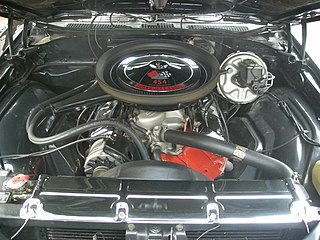
The Chevrolet "big-block" engine is a term for a series of large-displacement, naturally-aspirated, 90°, overhead valve, gasoline-powered, V8 engines; that were developed and produced by the Chevrolet Division of General Motors, from the 1950s until present.

The Batmobile is the car driven by the superhero Batman. Housed in the Batcave, which it accesses through a hidden entrance, the Batmobile is both a heavily armored tactical assault vehicle and a personalized custom-built pursuit and capture vehicle that is used by Batman in his fight against crime. Using the latest civilian performance technology, coupled with prototype military-grade hardware—most of which was developed by Wayne Enterprises—Batman creates an imposing hybrid monster car to prowl the streets of Gotham City.

George Barris was an American designer and builder of Hollywood custom cars. Barris designed and built the Hirohata Merc. Barris's company, Barris Kustom Industries, designed and built the Munster Koach and DRAG-U-LA for The Munsters; and the 1966 Batmobile for the Batman TV series and film.

The Jaguar C-Type is a racing sports car built by Jaguar and sold from 1951 to 1953. The "C" stands for "competition".

Kustom Kulture is the artworks, vehicles, hairstyles, and fashions of those who have driven and built custom cars and motorcycles in the United States of America from the 1950s through today. It was born out of the hot rod culture of Southern California of the 1960s.
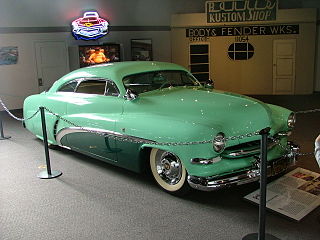
A custom car is a passenger vehicle that has been altered to improve its performance, change its aesthetics, or combine both. Some automotive enthusiasts in the United States want to push "styling and performance a step beyond the showroom floor - to truly craft an automobile of one's own." A custom car in British usage, according to Collins English Dictionary, is built to the buyer's own specifications.

The 1957 Chevrolet is a car that was introduced by Chevrolet in September 1956 for the 1957 model year. It was available in three series models: the upscale Bel Air, the mid-range Two-Ten, and the economy/fleet model One-Fifty. A two-door station wagon, the Nomad, was produced as a Bel Air model. An upscale trim option called the Delray was available for Two-Ten 2-door sedans. It is a popular and sought after classic car. These vehicles are often restored to their original condition and sometimes modified. The car's image has been frequently used in toys, graphics, music, movies, and television. The '57 Chevy, as it is often known, is an auto icon.
DRAG-U-LA, along with the Munster Koach, was one of two cars on the television show The Munsters designed by prolific show car designer Tom Daniel while working for George Barris and Barris Kustom Industries.
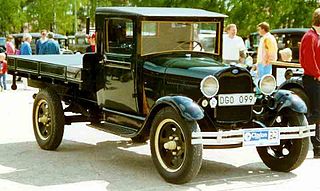
Ford Model AA is a truck from Ford. As the Model T and TT became obsolete and needed to be replaced, Henry Ford began initial designs on the Model A and Model AA in 1926. Basic chassis layout was done rapidly and mechanical development was moved forward quickly. Body design and style was developed and then outsourced to various body manufacturers, including Briggs and Murray. The designs of the Model A shared parts and materials with the Model AA Ford, notably the body, engine and interior. The AA usually received plainer interiors than their car counterparts. The Model AA followed similar design changes to the Model A during the AA's four years in production, often delayed anywhere from three to nine months. The mechanical changes and upgrades were done during production of the vehicles. Body changes that occurred between 1929 and 1930 were also integrated into AA production, but leftover parts were used longer in the heavy commercial trucks.

The Monkeemobile is a modified Pontiac GTO that was designed and built by designer Dean Jeffries for The Monkees, a pop and rock musical band and television program. The car features a split two-piece windshield, a touring car convertible top, modified rear quarter panels and front fenders, exaggerated tail lamps, set of four bucket seats and an extra third row bench where there was originally a trunk, a rear-mounted parachute and a GTO emblem on the front grille.

The Cadillac Series 355 was a V8-powered luxury car manufactured by Cadillac from 1931 until 1935. It was offered as a 2-door club coupe, 2-door convertible, 4-door convertible, 4-door sedan, 4-door town car, and 4-door limousine. It provided a range of Cadillac below the maker's larger V-12 and V-16 lines. It was succeeded by the Cadillac Series 70/75.
Dick Dean, born Richard Dean Sawitskas [Sa-WITS-kas], was an American automobile designer and builder of custom cars.

The Class-B Standardized Military Truck or "Liberty Truck" was a heavy-duty truck produced by the United States Army during World War I. It was designed by the Quartermaster Corps with help from the Society of Automotive Engineers in 1910 in an effort to help standardize the immense parts catalogue and multiple types of vehicles then in use by the US military, as well as create a truck which possessed all the best features of heavy truck technology then available. It was the first official standardized motor vehicle adopted and produced by the US Military.
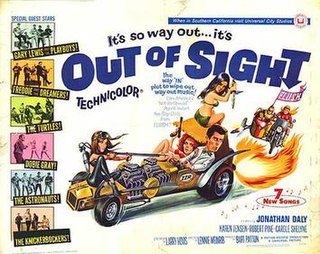
Out of Sight is a 1966 comedy film with elements of the spy spoof. It is the third and last of a series of films geared at teenagers by director Lennie Weinrib and producer Bart Patton for Universal Pictures.

The Cadillac V-12 is an exclusive V-12 powered luxury car that was manufactured by Cadillac from the 1930 through the 1937. Below only the maker's top-of-the-line Cadillac V-16 line, these were powered by the Cadillac V12 engine, furnished with similar custom bodies, and built in relatively small numbers. A total of 10,903 were made in the seven model years that the automobile was built, with the majority having been constructed in its inaugural year. It was Cadillac's first, and is to date, Cadillac's only standard production V-12 automobile.
Ala Kart is a custom car, a customized 1929 Ford Model A roadster pickup, built by George Barris, Richard Peters, and Mike "Blackie" Gejeian in 1957. Originally owned by Peters, it is a two-time winner of the Grand National Roadster Show "America's Most Beautiful Roadster" (AMBR) trophy and Hot Rod cover car in October 1958. Featured in hundreds of car shows, Ala Kart has won more than 200 trophies. It has also made numerous appearances in movies, usually in the background of drive-in shots, and dozens of magazine articles since. It is considered by many to be "one of the most iconic hot rods ever built."
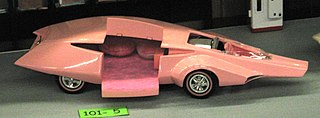
The Panthermobile is a show car built for the cartoon TV series The Pink Panther Show.

















